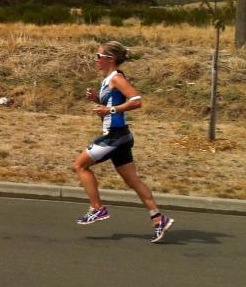Run Free With Stretching & Optimal Posture
Published on
17 Sep 2014

Call us on: (03) 9975 4133
When we watch elite runners we see them gliding forwards without hindrance, says Pure Director Kate Senini. We see free flowing limbs, yet a strong and stable trunk. We see a perfect example of symmetry, balance and muscle control. We see the ideal running posture.
When we watch elite runners we see them gliding forwards without hindrance, says Pure Director Kate Senini. We see free flowing limbs, yet a strong and stable trunk. We see a perfect example of symmetry, balance and muscle control. We see the ideal running posture.
The reality for leisure based runners is we spend most of our day in a sitting based occupation. We become slouched and moulded to the seat. Our spine stiffens into a flexed posture. Abnormal tension of the soft tissues develops through the front of our shoulders, chest and hips. Our ribcage is condensed. Our posture becomes unbalanced and asymmetrical with poor muscle control. It should therefore come as no surprise that most of us have experienced tension and restriction throughout the body whilst running, and yet it’s common to hear runners ask why they feel hindered, heavy, and lacking propulsion.
The answer to this hindrance when running lies largely in the posture of a runner. The carry over from poor sitting posture to running posture is greater than we realise. The soft tissues of the body play a major role in our ability to achieve optimal posture. These tissues include muscle, fascia (connective tissue) and neural tissue. The decrease in length of these soft tissues restricts optimal function of the tissues as well as preventing normal range of movement through each joint. This in turn leads to dysfunction in muscle control and strength.
It is important to maintain soft tissue mobility and normalise joint range of motion in order to create our ideal running posture. So how can we achieve this? The answer is a multi faceted approach to stretching, with a program consisting of both static and dynamic stretches.
Static Stretching
This is important to target specific muscles that lie across an individual joint. We must consider which specific muscle we wish to stretch in order to achieve symmetry throughout the body. This form of stretching must be sustained for 30 seconds to allow our stretch reflex to reverse and the muscle fibres to relax and lengthen. The stretch must be comfortable as overstretching can cause muscle tears. Static stretching should only be performed following a warm up.
For a sitting based occupation it is important that we target the muscles through the front of the body which typically remain in a shortened position throughout the work day. This includes the hip flexors (iliopsoas), quadriceps and pectorals. It is also common to develop tightness through the low back in cases where deep abdominal muscle control is reduced.
Dynamic Stretching
Dynamic stretching refers to improving muscle length through mobilisation. This form of lengthening takes a global approach to combined mobility of muscle, fascia and nerve tissue simultaneously. The movement is taken to the point of stretch, held for 2-3 seconds then back off to release, held at this point for 2-3 seconds then return again to the point of stretch. This is repeated 10-15 times, each time enabling the tissue to be taken further into its range/length and thus achieving greater tissue length. Encourage symmetry in the soft tissues with flowing oscillatory movements. These exercises influence the muscle, fascia (connective tissue) and nerve tissue simultaneously. The intergration of our soft tissues is often poorly understood.
A rehab physio can personalise a program for you, email us to book and appointment.
Back to blog home